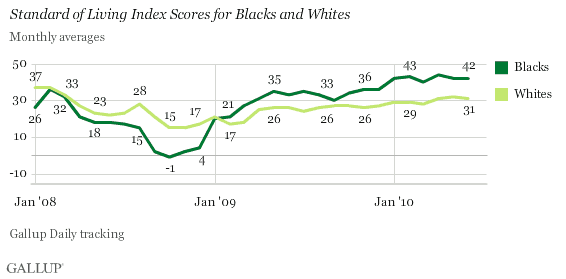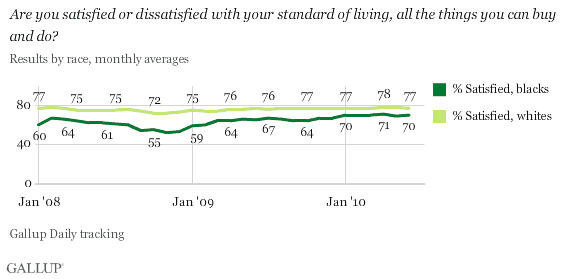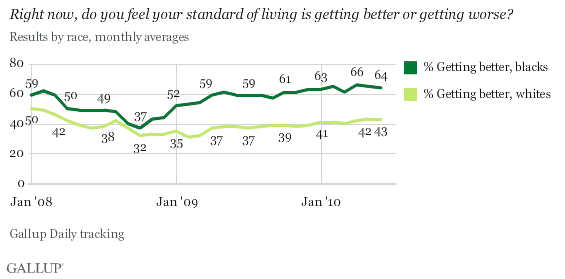PRINCETON, NJ -- Blacks' ratings on Gallup's Standard of Living Index continue to exceed those for whites, a pattern that has persisted since early 2009.

Gallup tracks its Standard of Living Index daily, based on how respondents rate their satisfaction with their standards of living and their assessments of whether they are getting better or getting worse. These Index scores -- reported as monthly averages here -- are usually positive because Americans tend to rate their standards of living more positively than negatively on both counts.
Both blacks' and whites' evaluations of their standards of living declined during the financial crisis in 2008, and the Index score for blacks dipped into negative territory in October 2008. Whites' scores remained higher than blacks' throughout 2008.
But blacks' evaluations of their standards of living recovered more rapidly than whites', and by February 2009, the score for blacks overtook that for whites and has remained higher ever since. The improvement in blacks' ratings of their standards of living is evident in both items that make up Gallup's Index.
Satisfaction With Standards of Living
An average of 70% blacks this year say they are satisfied with their standards of living. That compares with an average of 64% in 2009 and the low point of 52% satisfaction in November 2008.
Meanwhile, whites' satisfaction with their standards of living has remained relatively flat, even during the height of the financial crisis. Whites continue to be more likely than blacks to say they are satisfied with their standards of living, though the gap has shrunk, from 20 percentage points in late 2008 to 7 points today.

Standards of Living Getting Better or Worse
More than 60% of blacks each month in 2010 say their standards of living are getting better. Those assessments are improved from 2009, and represent a dramatic turnaround from the height of the financial crisis, when 37% of blacks said their standards of living were improving (at that time, 49% of blacks said theirs were getting worse).
The percentage of whites who say their standards of living are getting better has improved much less than that of blacks, at 43% today compared with 32% in October 2008. Whites have been consistently less likely than blacks to say their standards of living are getting better since Gallup tracking began in January 2008.

Blacks' higher average Standard of Living Index score, then, is the result of greater optimism among blacks than among whites that their standards of living are improving, a gap that has expanded, coupled with the narrowing of the white-black gap in the percentage satisfied with their living standards.
The pattern in which whites are more likely than blacks to express satisfaction with their standards of living, but blacks are more likely than whites to say their living standards are getting better, may reflect U.S. economic realities. Whites as a group have higher average standards of living than blacks, so while more whites are probably now at a place of relative financial security, it is not one from which they see much room for improvement. On the other hand, blacks may see more room for improvement because they are in general a group with more room to move upward. Gallup has also found Hispanics to be quite optimistic about improvements in their standards of living.
Bottom Line
Blacks have become more optimistic about their standards of living since the financial crisis of 2008. It is not clear whether this is grounded in real economic gains for blacks over this time, or whether it is merely the result of greater optimism among blacks in general about the economic climate for the United States and their own families.
The latter explanation seems more likely, given that blacks began to be more optimistic around the same time that Barack Obama was inaugurated as president, but before his economic policies could have had a tangible impact on Americans' lives. Blacks voted overwhelmingly for Obama in 2008 and continue to support him at high levels today even as his overall approval rating has declined.
Survey Methods
Results are based on telephone interviews conducted as part of Gallup Daily tracking June 1-30, 2010, with a random sample of 30,189 adults, aged 18 and older, living in all 50 U.S. states and the District of Columbia, selected using random-digit-dial sampling.
For results based on the total sample of national adults, one can say with 95% confidence that the maximum margin of sampling error is ±1 percentage point.
For results based on the total sample of 1,914 blacks, one can say with 95% confidence that the maximum margin of sampling error is ±3 percentage points.
Interviews are conducted with respondents on landline telephones and cellular phones, with interviews conducted in Spanish for respondents who are primarily Spanish-speaking. Each daily sample includes a minimum quota of 150 cell phone respondents and 850 landline respondents, with additional minimum quotas among landline respondents for gender within region. Landline respondents are chosen at random within each household on the basis of which member had the most recent birthday.
Samples are weighted by gender, age, race, Hispanic ethnicity, education, region, adults in the household, cell phone-only status, cell phone-mostly status, and phone lines. Demographic weighting targets are based on the March 2009 Current Population Survey figures for the aged 18 and older non-institutionalized population living in U.S. telephone households. All reported margins of sampling error include the computed design effects for weighting and sample design.
In addition to sampling error, question wording and practical difficulties in conducting surveys can introduce error or bias into the findings of public opinion polls.
For more details on Gallup's polling methodology, visit https://www.gallup.com/.
